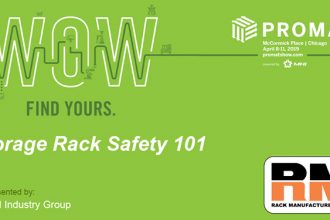Planning and Using Industrial Steel Storage Racks: What you need to consider

As the state of warehousing and distribution evolves, so too does the equipment that supports operations. To keep up with those changes, the MHI’s Rack Manufacturers Institute (RMI) has compiled an updated guide on considerations for the planning and use of steel storage racks. It is essential to ensure you are first complying with all federal, state and local regulations and codes pertaining to this equipment. However, the updated RMI guide can serve as a valuable resource as you undertake new steel racking projects.
The updated guide provides detailed information on all phases of an industrial rack project, beginning with the planning phase. This section updates all the ingredients and requirements that go into this initial phase of the project. It is followed up by a lengthy list of the many types and variations of storage racks and their operations.
Should your facility not have in-house engineering, the guide also lists design parameters you’ll need to consider, with the recommendation that you hire an outside material handling expert as required. Together, says the guide, you can determine responsible parties for a long list of installation tasks, which the guide supplies in specific detail.
Other considerations that the guide updates include RMI standards for design, which follow specific ANSI material handling standards. Reinforcing these standards are a list of RMI companies that have earned the “R-Mark” seal, which certifies the racking meets the ANSI standards. The guide spells out what this means specific to each piece of racking involved, along with accompanying photos.
The 56-page guide includes all aspects of installation including the planning details. With the advice that users strictly adhere to the manufacturer’s specifications, the guide provides information on installations drawings, capabilities, support, and project coordination, among others. It also addresses modifications and how to go about ensuring any plans for doing so receive rack system designer approval.
Once users have made it through the planning, design and installation sections, the updated guide addresses the aspects of inspection. The guide points out that this phase will cover both the welded fabrication and the floor anchors in a new racking installation. Independent inspectors will oversee the detailed look over and ensure that the racking follows all standards and individual manufacturer specifications.
The guide shares recommendations on the frequency of inspections, as well as maintenance, pointing out that ultimately, the owner is responsible for ensuring the rack is maintained properly. The guide instructs on personnel training, inspection for damage and what to do following seismic activity. Wrapping up the inspection section is a sample rack inspection form, with details on how to complete the various sections.
Finally, the guide wraps up with information on how to proceed should racks become damaged and need repair. This section spells out how to replace damaged parts, or if possible, how to repair them. Every section of the guide is designed for a safe, functional, and long-lasting rack installation project.


